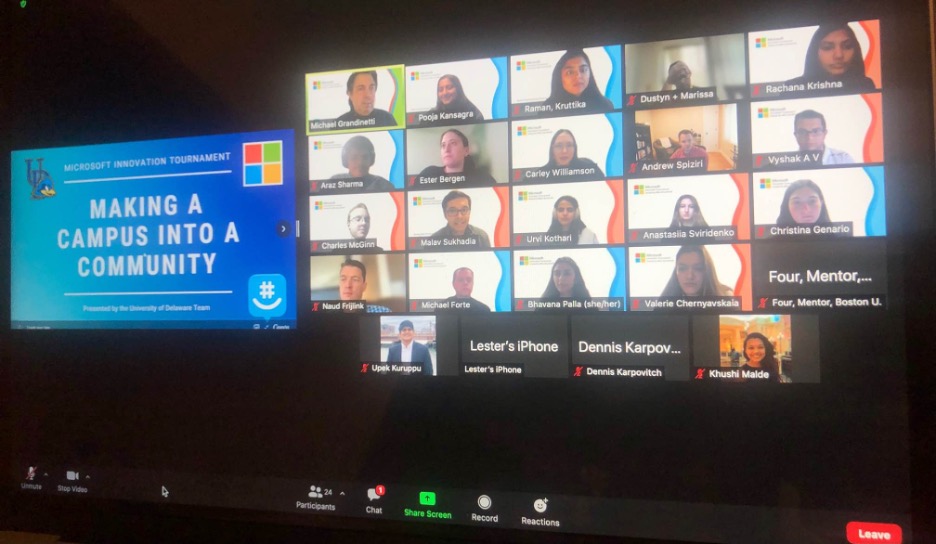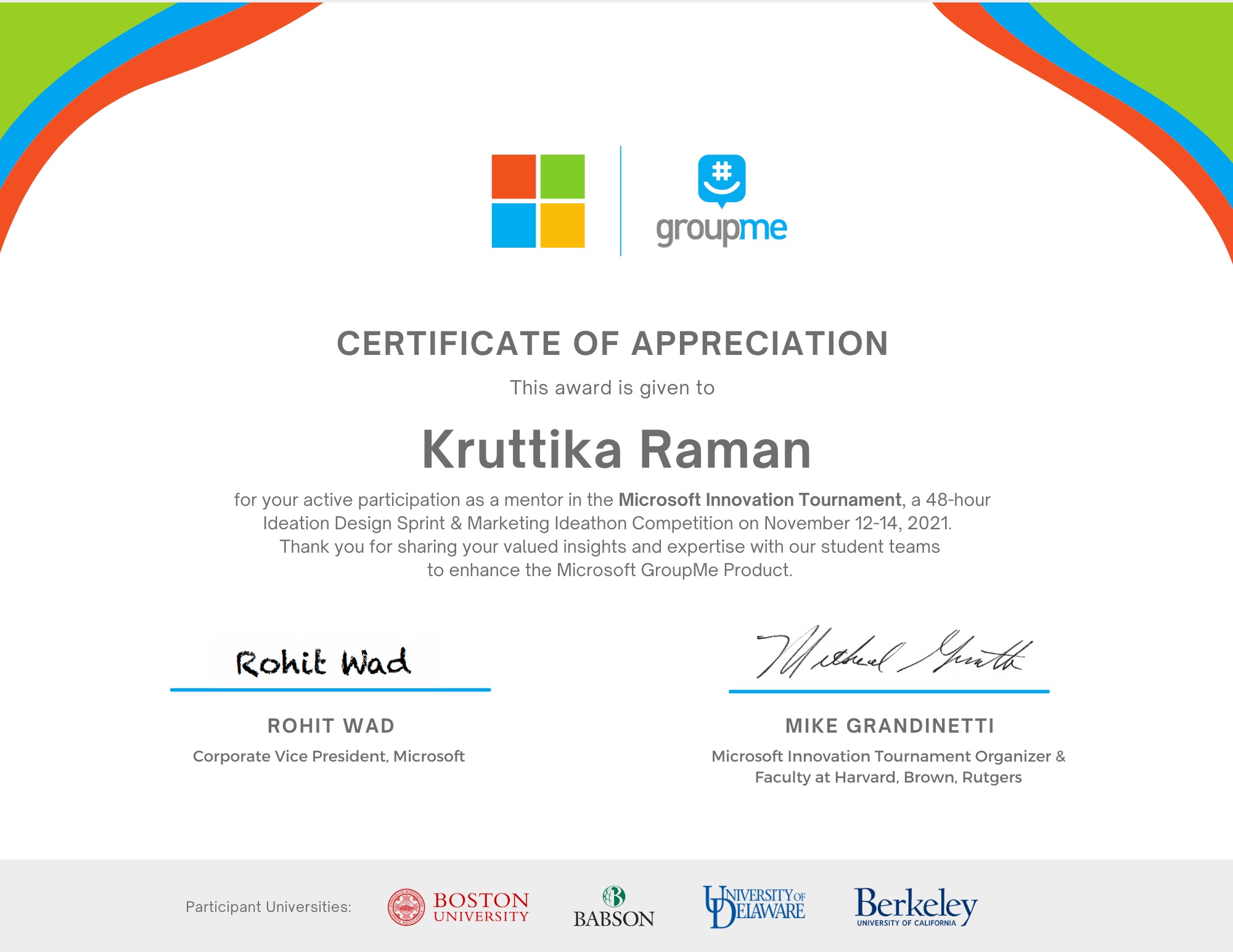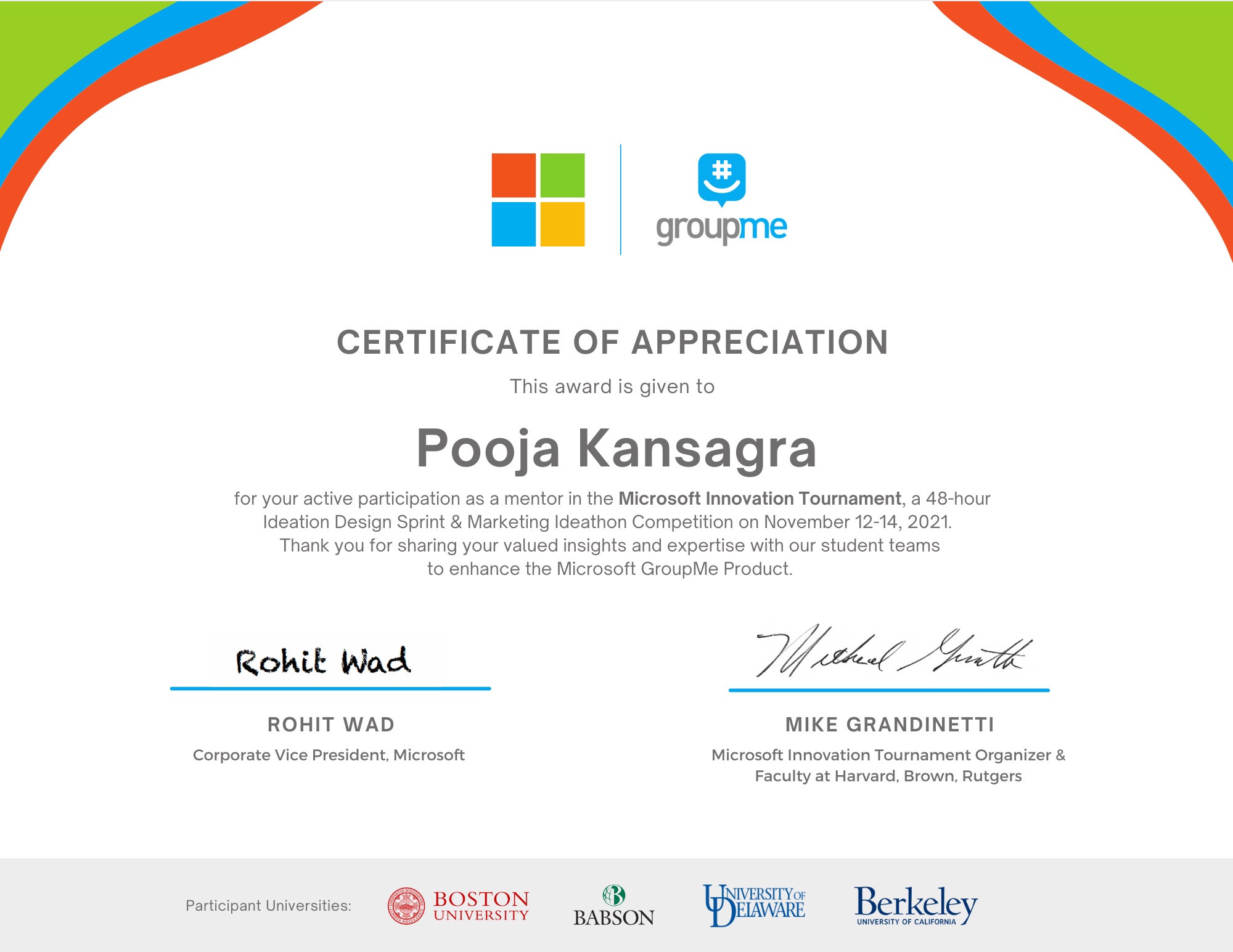In the world of tech, entrepreneurship, and thought leadership, few people are as active as innovation expert Mike Grandinetti, an award-winning strategist and creator of MBS’s signature Design Innovation course—a project-oriented class in which students learn fundamental aspects of human-centered, iterative, and prototype-driven processes for breakthrough innovations, as well as key business aspects of product commercialization.
 This past summer, Grandinetti’s course yielded design solutions so viable that Grandinetti (pictured at left) called his contacts at Microsoft—and landed MBS student Pooja Kansagra an opportunity to present her suggestions to Microsoft’s GroupMe leadership team, a multidisciplinary group of designers, engineers, and program managers.
This past summer, Grandinetti’s course yielded design solutions so viable that Grandinetti (pictured at left) called his contacts at Microsoft—and landed MBS student Pooja Kansagra an opportunity to present her suggestions to Microsoft’s GroupMe leadership team, a multidisciplinary group of designers, engineers, and program managers.
Kansagra’s ideas not only impressed the team, but led to a Microsoft-sponsored innovation tournament / design sprint, which Kansagra and alumna Kruttika Raman MBS’21 ultimately helped mentor.
Raman, Grandinetti’s summer teaching assistant and class mentor, helped Kansagra prepare for her presentation and also continues to work with Grandinetti, mentoring in a select number of his graduate courses on innovation and leadership at Harvard.
Kansagra’s ideas—along with those generated in the tournament—have been forwarded to Microsoft engineers for implementation. Here, Grandinetti, Kansagra (pictured below, left), and Raman (pictured below, right) discuss the journey of taking a classroom idea from concept to market at the very highest level.


From Concept to Market: An Innovation Journey
Grandinetti: I'm a very big believer in experiential education, mostly because of my own experience at Rutgers. I received my undergraduate degree in engineering, and—as most people know—the study of engineering almost everywhere in the world is highly theoretical. Meaning, you take six semesters of calculus and four semesters of physics and a lot of very math-oriented courses—not even applied math-oriented courses—and you never use that knowledge again.
Grandinetti: After graduation, I launched two successful startups and started teaching at MIT. I began thinking that there had to be a more effective, more satisfying way to engage students. So every course I've taught from that point forward has been experiential in nature and fully hands-on—enabling students to take classroom instruction and immediately apply it, which I feel is the best way to truly learn. In the Design Innovation course, students work in teams, which is a much more accurate reflection of how real-world problem-solving is executed.
Grandinetti: For this summer’s class, I had students select a company and a product that they wanted to improve, and Pooja and her team selected Microsoft’s GroupMe app. Pooja?
Kansagra: I proposed GroupMe to our team because I used it a lot already, and always had tons of issues whenever I made group chats—most team group chats in my other courses were through GroupMe, and I was so frustrated as a user. I told the team, “There are definitely a lot of problems we can fix here.” And they were all on board.
Kansagra: We started researching GroupMe as a business—how GroupMe profits and monetizes their products and services. Because at the end of the day, that's what a business does. The goal is to make money and have people use the product. As a User Experience Design (UXD) major, my courses prior to Professor Mike’s class had focused on usability and design; however, this course focused on innovation from the business side, which was fascinating to me.
Grandinetti: As a professor, you very quickly see those students who are dedicated to learning and growing, and those who are not. Because not everybody comes into a graduate program fully willing to learn—maybe they’re checking boxes, but not necessarily throwing themselves into their coursework. Then, there are exceptional students like Pooja and Kruttika who do outstanding, superior work.
Grandinetti: It was clear from day one that Pooja was setting a pace for the rest of her classmates in terms of her professionalism, her work ethic, and her willingness to be coached. It was clear that this was a student who was really going to take it to the limit, which to me is why I teach. These are the kind of students I live to teach. Kruttika had been that exact same student a year before—which is how she wound up as my teaching assistant this summer. Kruttika has since become an incredibly trusted collaborator of mine, both at Rutgers and at Harvard.
Grandinetti: After the semester ended, I said to Pooja, “you did such a great job. I cannot promise you anything, but I have some contacts at Microsoft, and I think there may be an opportunity to get to the GroupMe team and have you present to them.” One thing led to another, and it took us about a month to finally land a meeting, and by that time Kruttika had joined as a mentor.

Kansagra: Part of the Design Innovation course was dedicated to learning how to pitch ideas—how to determine the most critical information as well as how to present that information—like, not going on and on for 20 minutes. By the time I had the opportunity to present to the GroupMe team, I was able to put together a solid presentation and fully understand the exact pitch I needed to make—what points to emphasize, what information to convey, and how to engage my audience. I can’t imagine I’d have learned those critical steps and techniques in any other class.
Grandinetti: Pooja spent an hour presenting to the entire GroupMe leadership team, and, quite frankly, she rocked it. As a matter of fact, ten minutes into the presentation they stopped her to tell her how awesome she was. So as a professor, you can imagine how proud that made me. And Kruttika was with us every step of the way.
Grandinetti: Now, the GroupMe team is committed to growing use of their product and having it become far more broadly adopted on university campuses around the world. With Pooja’s presentation. As the leadership team processed the viability of Pooja’s ideas and the value of her creative insights as a user—they clearly connected how Pooja’s ideas had the potential to greatly increase GroupMe’s virality.
Grandinetti: After Pooja’s presentation, one of the leaders came up and asked me, “If you can facilitate that kind of innovative thinking with students in one team or class, can you do that at scale?” I said, “Of course.” and then proceeded to organize an innovation tournament where students would get anywhere from 24 to 72 hours to provide rapid solutions to a problem. Perhaps not perfect or elegant solutions, but solutions that work. And honestly, it's amazing to see what creativity and innovation and comes out of a small group when they know time is limited. The time pressure really focuses the mind. There's no joking around.
Grandinetti: For the tournament, GroupMe decided to select those schools with largest, most robust numbers of GroupMe users, and Rutgers was not one of them. However, I asked Kruttika and Pooja to stay on as tournament mentors, which they did—they coached the design sprint track for the University of Delaware.
Then, eighteen presentations later, the event ended, and Microsoft leaders couldn't have been happier—they’ve hired engineers to take on ideas that Pooja shared, first and foremost, and tournament participants shared.


Grandinetti: In all, we had about 100 people in the community over the weekend. None of this would've happened without Pooja. It was her ideas—her excellent work, her ambition, which I say with pride, and her growth mindset—that led to the tournament.
I teach at a number of universities, and one thing that makes the MBS program unique is the consistent cultivation of a “design mindset” among students. I credit [MBS executive director] Deborah Silver, and her commitment to incorporating design thinking throughout the curriculum. When she and I first discussed my teaching a course at Rutgers, she gave me the freedom to create the course as I saw fit. Given how closely aligned our thinking is on the importance of human-centered design principles, I was confident that my course pedagogy and corresponding syllabus would fit in well to the overall Rutgers MBS degree program ethos.
Raman: Agreed. When I took the Design Innovation course as an MBS student, I was immersed in an environment of, “we all are here to learn and grow together.” that’s what comes with Mike as a professor but you also have so many resources within the MBS program—an abundance. So, it's up to a student how they want to learn and grow. There's no lack of opportunity for guidance. And even after you graduate, that program relationship exists. With Mike especially, it's not like I was just in his class once and will never see him again. It’s an ongoing relationship, and with that comes a lot of contact.
Grandinetti: Well, I’d say there’s no lack of opportunity for those students who have earned it, and if you are a student like Kruttika and Pooja who have what I call very clearly a growth mindset and a commitment to excellence, I will do everything in my power to give you the ability to do whatever it is that you want to do professionally. To give a student like Pooja a chance to present to Microsoft, to shape a team’s thinking, to potentially get a job there—it’s what teaching is all about.
Kansagra recently won the Master of Business and Science program Fellowship, a huge honor, which she credits with possessing a growth mindset as well. “Just having that commitment to work as hard as possible and put all your energy into what you produce, it’s almost like an innate personality—at least for me that's how I've always been," says Kansagra. "I'm sure Kruttika is also the same way in always wanting to be better.”
Grandinetti: As someone who has been a practitioner of innovation and entrepreneurship and design for my entire career, I’ve also blessed with the opportunity to share my experiences as a professor and mentor with some very amazing students. And for me personally, being able to give students like Pooja as much visibility as possible—for Pooja, that means visibility at Microsoft and to the GroupMe team, which now knows her very, very well—it is incredibly gratifying. My involvement in tech and innovation and startups has led to a rich network of contacts, and there is nothing better than connecting an amazing student with an amazing opportunity. It’s a win, win, win—for the student, the employer, and for me.
------------------------------------------------------